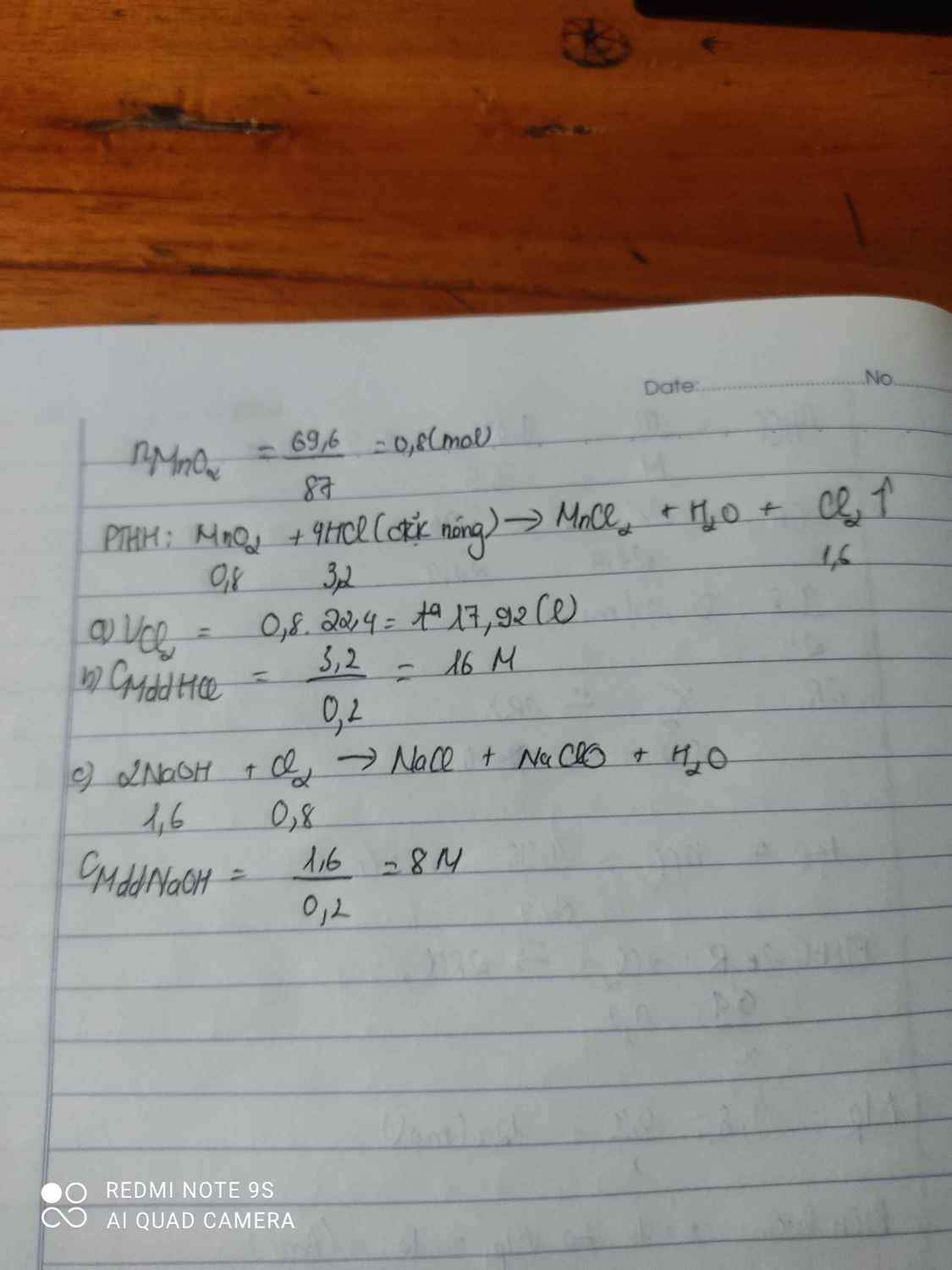Hãy nhập câu hỏi của bạn vào đây, nếu là tài khoản VIP, bạn sẽ được ưu tiên trả lời.

\(n_{Zn}=\dfrac{m_{Zn}}{M_{Zn}}=\dfrac{13}{65}=0,2mol\)
PTHH: Zn + 2HCl \(\rightarrow\) ZnCl2 + H2
TL: 1 : 2 : 1 : 1
mol: 0,2 \(\rightarrow\) 0,1 \(\rightarrow\) 0,2 \(\rightarrow\) 0,2
đổi 500ml = 0,5 l
\(a.C_{M_{ddHCl}}=\dfrac{n_{HCl}}{V_{HCl}}=\dfrac{0,1}{0,5}=0,2M\)
\(b.m_{ZnCl_2}=n.M=0,2.136=27,2g\)
\(V_{H_2}=n.22,4=0,2.22,4=4,48l\)
c.
Màu của quỳ tím sẽ chuyển sang màu đỏ.
Giải thích:
- Phản ứng giữa axit HCl và bazơ KOH tạo ra muối KCl và nước: HCl + KOH → KCl + H2O
- Vì dung dịch KOH là bazơ, nên khi phản ứng với axit HCl thì sẽ tạo ra dung dịch muối KCl và nước.
- Muối KCl không có tính kiềm, nên dung dịch thu được sẽ có tính axit.
- Khi cho mẫu quỳ tím vào dung dịch axit, quỳ tím sẽ chuyển sang màu đỏ do tính axit của dung dịch.
\(n_{Zn}=\dfrac{13}{65}=0,2\left(mol\right)\)
Pt : \(Zn+2HCl\rightarrow ZnCl_2+H_2\)
0,2----->0,4------>0,2---->0,2
a) \(C_{MddHCl}=\dfrac{0,4}{0,5}=0,8M\)
b) \(m_{muối}=m_{ZnCl2}=0,2.136=27,2\left(g\right)\)
\(V_{H2\left(dktc\right)}=0,2.22,4=4,48\left(l\right)\)
c) \(n_{KOH}=\dfrac{5,6\%.200}{100\%.56}=0,2\left(mol\right)\)
Pt : \(KOH+HCl\rightarrow KCl+H_2O\)
0,2 0,4
Xét tỉ lệ : \(0,2< 0,4\Rightarrow HCldư\)
Khi cho quỳ tím vào dụng dịch sau phản ứng --> quỳ hóa đỏ (do HCl có tính axit)

Phản ứng thuộc phản ứng oxh- khử
VHCl= 400ml => VHCl= 0,4 lít
mZn= 1.3g => nZn= mZn/MZn = 1.3/65 = 0.02(mol)
Zn + 2HCl ---> ZnCl2 + H2
1 2 1 1
mol: 0.02 0.04 0.02 0.02
a) mZnCl2 = nZnCl2 . MZnCl2 = (0.02)( 65+ 35,5.2) =2,72g
b) VH2= nH2. 22,4 = 0.02 . 22.4 = 0.448(lít)
c) CM(HCl)= nHCl/VHCl = 0.04/0.4 = 0,1 M

Bài 14 :
\(n_{Fe}=\dfrac{8,4}{56}=0,15\left(mol\right)\)
Pt : \(Fe+2HCl\rightarrow FeCl_2+H_2|\)
1 2 1 1
0,15 0,3 0,15 0,15
a) \(n_{H2}=\dfrac{0,15.1}{1}=0,15\left(mol\right)\)
\(V_{H2\left(dktc\right)}=0,15.22,4=3,36\left(l\right)\)
b) \(n_{HCl}=\dfrac{0,15.2}{1}=0,3\left(mol\right)\)
\(V_{ddHCl}=\dfrac{0,3}{2}=0,15\left(l\right)\)
c) \(n_{FeCl2}=\dfrac{0,15.1}{1}=0,15\left(mol\right)\)
\(C_{M_{FeCl2}}=\dfrac{0,15}{0,15}=1\left(M\right)\)
Chúc bạn học tốt
ở đoạn c bạn có ghi nhầm ko à , tại mình cứ thấy nó sai sai

\(n_{Zn}=\dfrac{130}{65}=2mol\\ Zn+2HCl\rightarrow ZnCl_2+H_2\\ n_{Zn}=n_{H_2}=2mol\\ V_{H_2}=2.22,4=44,8l\\ 1000ml=1l\\ n_{HCl}=2.2=4mol\\ C_{M_{HCl}}=\dfrac{4}{1}=4M\)
\(n_{Zn}=\dfrac{m_{Zn}}{M_{Zn}}=\dfrac{130}{65}=2mol\)
PTHH: Zn + 2HCl \(\rightarrow\) ZnCl2 + H2
TL; 1 2 1 1
mol: 2 \(\rightarrow\) 4
\(m_{HCl}=n.M=4.36,5=146g\)
đổi 1000 ml= 1l
\(C\%_{ddHCl}=\dfrac{m_{HCl}}{V_{HCl}}.100\%=\dfrac{146}{1}.100=14600\%\)
số hơi lớn em xem lại đề nhé

200ml = 0,2l
\(n_{Zn}=\dfrac{19,5}{65}=0,3\left(mol\right)\)
Pt : \(Zn+2HCl\rightarrow ZnCl_2+H_2|\)
1 2 1 1
0,3 0,6 0,3 0,3
a) \(n_{ZnCl2}=\dfrac{0,3.1}{1}=0,3\left(mol\right)\)
\(C_{M_{ZnCl2}}=\dfrac{0,3}{0,2}=1,5\left(M\right)\)
b) \(n_{H2}=\dfrac{0,3.1}{1}=0,3\left(mol\right)\)
\(V_{H2\left(dktc\right)}=0,3.22,4=6,72\left(l\right)\)
c) Pt : \(NaOH+HCl\rightarrow NaCl+H_2O|\)
1 1 1 1
0,6 0,6
\(n_{NaOH}=\dfrac{0,6.1}{1}=0,6\left(mol\right)\)
\(m_{NaOH}=0,6.40=24\left(g\right)\)
\(m_{ddNaOH}=\dfrac{24.100}{20}=120\left(g\right)\)
Chúc bạn học tốt

\(a) Zn +2 CH_3COOH \to (CH_3COO)_2Zn + H_2\\ b) n_{H_2} = n_{Zn} = \dfrac{13}{65} = 0,2(mol)\\ V_{H_2} = 0,2.22,4 = 4,48(lít)\\ n_{CH_3COOH} = 2n_{Zn} = 0,4(mol) \Rightarrow V_{dd\ CH_3COOH} = \dfrac{0,4}{1} = 0,4(lít)\\ c) C_2H_5OH + O_2 \xrightarrow{men\ giấm} CH_3COOH + H_2O\\ n_{C_2H_5OH\ pư} = n_{CH_3COOH} = 0,4(mol)\\ m_{C_2H_5OH\ cần dùng} = \dfrac{0,4.46}{90\%} = 20,44(gam)\)

1: \(n_{Zn}=\dfrac{3.25}{65}=0.05\left(mol\right)\)
a: \(Zn+2HCl\rightarrow ZnCl_2+H_2\uparrow\)
0,05 0,1 0,05 0,05
\(m_{dd\left(HCl\right)}=0.1\cdot36.5=3.65\left(g\right)\)
b: \(V_{H_2}=0.05\cdot22.4=1.12\left(lít\right)\)
2)
H3PO4 (axit yếu) : axit photphoric
Zn3(PO4)2 (muối) : kẽm photphat
Fe2(SO4)3 (muối) : sắt (III) sunfat
SO2 (oxit axit) : lưu huỳnh đioxit
SO3 (oxit axit) : lưu huỳnh trioxit
P2O5 (oxit axit) : đi photpho pentaoxit
HCl(axit mạnh) : axit clohidric
Ca(HCO3)2 (muối axit) : canxi hidrocacbonat
Ca(H2PO4)2 (muối aixt) : canxi đihidrophotphat
Fe2O3 (oxit bazơ) : sắt (III) oxit
Cu(OH)2 (bazơ) : đống(II) hidroxit
NaH2PO4 (muối axit) : natri đihidrophotphat
Chúc bạn học tốt

Sửa đề: 0,5 mol → 0,5 M
a, Ta có: \(n_{Zn}=\dfrac{2,6}{65}=0,04\left(mol\right)\)
PT: \(Zn+2HCl\rightarrow ZnCl_2+H_2\)
Theo PT: \(n_{HCl}=2n_{Zn}=0,08\left(mol\right)\)
\(\Rightarrow V_{HCl}=\dfrac{0,08}{0,5}=0,16\left(l\right)\)
b, Theo PT: \(n_{H_2}=n_{Zn}=0,04\left(mol\right)\Rightarrow V_{H_2}=0,04.22,4=0,896\left(l\right)\)
Sửa đề 0,5mol ⇒ 0,5M
\(n_{Zn}=\dfrac{2,6}{65}=0,04\left(mol\right)\)
Pt : \(Zn+2HCl\rightarrow ZnCl_2+H_2\uparrow\)
0,04 0,08 0,04
a) \(V_{ddHCl}=\dfrac{0,08}{0,5}=0,16\left(l\right)\)
b) \(V_{H2\left(dktc\right)}=0,04.22,4=0,896\left(l\right)\)
Chúc bạn học tốt